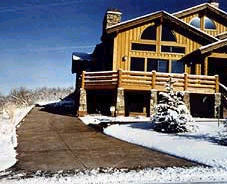Snow Melt Systems
Overview

Traditional snow melt systems 20 years ago consisted of small, spot radiant heaters hung above entrance ways and loading docks. They were either electric or gas fired and kept a few square feet free of ice build-up.
Today, snow melting systems are helping to push the season in northern climates for outdoor activities, and helping to keep all sorts of large walks and parking areas safer during winter months. Residential applications include walk ways and complete driveways.
A series of hydronic pipes are buried just under the surface or poured into the cement. The pipes are connected to headers and controls that are connected to gas boilers. If melting snow only, water temperature is generally lower (90 – 100F), but if also using for heating, such as airport hangers or outdoor maintenance areas, the temperature can be turned up.
 Operation
Operation
Very heavy plastic or rubber tubing is buried beneath brick and asphalt or into concrete surfaces. The system is generally designed so that there are no joints in the pipe in inaccessible areas. Each pipe loop is feed from and returned to a header in a common area. This way, most leaks could be repaired at the header, or leaking loops disconnected.
Some systems are installed with insulation below the piping; either rigid foam or roll-out reflective insulation consisting of a layer of aluminum foil sandwiched between two layers of polyethylene bubbles are used to form a thermal break. This can make the systems respond a little quicker, but don’t save much in annual operation costs, as most of the heat goes to the surface anyway. Systems should have some sort of ground temperature control, and may also have a surface moisture detector to turn up/on during periods of heavy snow fall.
Traditional boilers and water heaters are used on snow melt systems. Water temperature is typically only about 90F for systems that are always circulating, a little higher for systems that turn on and off. Small snow melt systems may have heaters of only 200,000 BTUs, where large installations could be several million BTUs with redundant boilers.
The benefits include:
- Comfort / Quality of Life – No more shoveling or sanding and it’s a tremendous time-saver.
- Safety – Keeps access to your home open and free from dangerous ice and snow. Helps prevent slips and falls, reduces liabilities due to snow and ice accumulating in pedestrian’s pathways.
- Reliable – Goes to work to prevent snow and ice from accumulating as soon as it starts to form.
- Economical – Eliminates contracted snow removal costs, eliminates the need for costly and dirty melting agents and sand applications.
- Cleaner – No salt or sand is tracked into heated spaces.
System Sizing
Snow melt systems are sized according to the application and local climate. Some applications may require NO accumulation of snow, while others may allow some accumulation during heavy snow falls and then gradually melt it, without forming an ice layer. Increasing the amount of pipe used (reducing spacing) will increase material costs, and increasing the operating temperature will increase the operating costs. If a dedicated boiler is to be used, there is a fixed cost for a boiler, no matter how much pipe is used.
A rule of thumb for boiler sizing is about 100 BTUs per square foot of piping area.
First and Operating Costs
Installed costs can easily be $5 to $10 per square foot, plus the cost of a boiler.
Operating cost is estimated at 50,000 to 100,000 BTUs per square foot per season.
Manufacturers
For an industry web site with more information and links to several manufacturers, see
www.concretenetwork.com /concrete/ snow_melting_systems
Uponor-USA (Formerly Wirsbo)
Apple Valley, Minnesota.
REHAU
Northeast Radiant
31 Hoyt Street, South Salem, New York 10590
Telephone: 914-763-3200
Watts Radiant
Springfield, MO
Telephone 800-276-2419
Source: Text Bob Fegan 4/02 Revised 12/2008; Manufacturer’s info from their web sites referenced and linked above; images from the Wirsbo web site; revised 5/2008 to Uponor-USA;
© 2008 Energy Solutions Center400 N. Capitol Street NWWashington, DC 20001 All rights reserved. Legal Contact our webmaster
